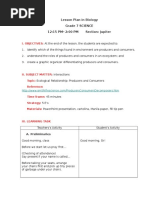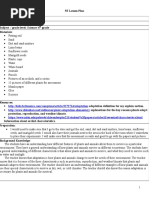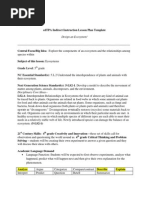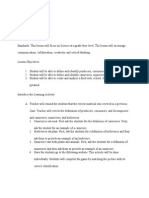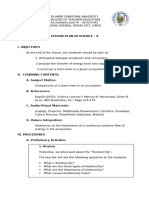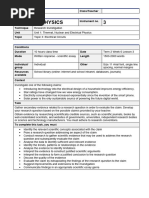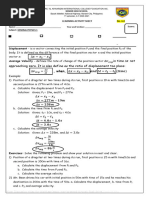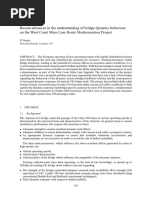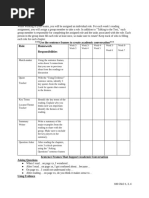0 ratings0% found this document useful (0 votes)
32 viewsLessonPlan Jhanvi
LessonPlan Jhanvi
Uploaded by
jhanvi bhosaleThe lesson plan aims to teach 7th grade students about nutrition in plants over 40 minutes. [1] It will introduce the differences between autotrophic and heterotrophic nutrition, explain the various modes of plant nutrition, and describe the process of photosynthesis. [2] Students will learn that plants are autotrophs that produce their own food through photosynthesis using water, carbon dioxide and sunlight. [3] An exit slip assessment asks students to classify organisms, define key terms, and answer questions to check their understanding of the concepts covered.
Copyright:
© All Rights Reserved
Available Formats
Download as PDF, TXT or read online from Scribd
LessonPlan Jhanvi
LessonPlan Jhanvi
Uploaded by
jhanvi bhosale0 ratings0% found this document useful (0 votes)
32 views5 pagesThe lesson plan aims to teach 7th grade students about nutrition in plants over 40 minutes. [1] It will introduce the differences between autotrophic and heterotrophic nutrition, explain the various modes of plant nutrition, and describe the process of photosynthesis. [2] Students will learn that plants are autotrophs that produce their own food through photosynthesis using water, carbon dioxide and sunlight. [3] An exit slip assessment asks students to classify organisms, define key terms, and answer questions to check their understanding of the concepts covered.
Original Description:
Lesson Plan on Nutrition in Plants
Original Title
LessonPlan_Jhanvi
Copyright
© © All Rights Reserved
Available Formats
PDF, TXT or read online from Scribd
Share this document
Did you find this document useful?
Is this content inappropriate?
The lesson plan aims to teach 7th grade students about nutrition in plants over 40 minutes. [1] It will introduce the differences between autotrophic and heterotrophic nutrition, explain the various modes of plant nutrition, and describe the process of photosynthesis. [2] Students will learn that plants are autotrophs that produce their own food through photosynthesis using water, carbon dioxide and sunlight. [3] An exit slip assessment asks students to classify organisms, define key terms, and answer questions to check their understanding of the concepts covered.
Copyright:
© All Rights Reserved
Available Formats
Download as PDF, TXT or read online from Scribd
Download as pdf or txt
0 ratings0% found this document useful (0 votes)
32 views5 pagesLessonPlan Jhanvi
LessonPlan Jhanvi
Uploaded by
jhanvi bhosaleThe lesson plan aims to teach 7th grade students about nutrition in plants over 40 minutes. [1] It will introduce the differences between autotrophic and heterotrophic nutrition, explain the various modes of plant nutrition, and describe the process of photosynthesis. [2] Students will learn that plants are autotrophs that produce their own food through photosynthesis using water, carbon dioxide and sunlight. [3] An exit slip assessment asks students to classify organisms, define key terms, and answer questions to check their understanding of the concepts covered.
Copyright:
© All Rights Reserved
Available Formats
Download as PDF, TXT or read online from Scribd
Download as pdf or txt
You are on page 1of 5
LESSON PLAN 1: Nutrition In Plants
Subject: Science
Class: VII
Chapter: Nutrition In Plants
Sub-topic: Modes of nutrition in Plants
No. of students: 20
Resources required: Classroom space, chalk, blackboard, laptop
Duration of the lesson: 40 minutes
Date: 31-03-2023
Objectives: Students will be able to
● Understand the difference between autotrophic and heterotrophic nutrition as well as
define both.
● Understand the different modes of nutrition in plants.
● Explain the process of photosynthesis.
Overview of the lesson plan:
● Introduction (5 mins)
● Different modes of nutrition (10 mins)
● Photosynthesis (10 mins)
● Exit slip+ doubt clearing (15 mins)
Phase-wise transaction of the lesson:
Phas Teacher’s Activity Students’ Activity Time
es required
I. Introducing the topic: Students think and try answering 5 mins
the following questions.
To do various activities like playing,
dancing, cycling, etc. what do we need?
How / from where do we get this
energy?
OR
What do we get from food? (depending
on the answer)
What do plants require to synthesize or
produce energy?
(Teacher notes the responses on the
board while the students answer these
questions)
II. Different modes of nutrition: 10 mins
Showing examples of food chains and Students observe the diagrams of
asking the students what is the common the food chain and look for the
trend that they observe here? common trend.
What is the reason behind plants being
the first organism in all the food
chains?
Teacher states that-
Plants are the only organisms that can
prepare their own food.
Such organisms that prepare their own As the teacher writes the new
food are called autotrophs, and the terms and their definition on the
mode of nutrition in which organisms board the students copy it in
produce their own food from simple their text.
substances is called autotrophic
nutrition. (auto = self; trophos =
nourishment)
Animals and most other organisms
make their food with the help of plants.
Such organisms are called
Heterotrophs and the mode of
nutrition is called heterotrophic
nutrition. (heteros = other)
Teacher asks for some examples of Students think of examples.
autotrophs and heterotrophs.
III. Photosynthesis: 10 mins
In response to the question asked in the Students think about the
introduction- question.
What do plants require to synthesize or
produce energy?
Follow up question for that would be-
What is the process called through
which plants make use of these things
to produce food/energy?
Do you know the process of
photosynthesis?
Questioning the students:
Where and how do the plants get water
and minerals from?
What do they get from the sunlight?
Where is this energy stored?
Teacher states that leaves are the food
factories of plants. Water and minerals
present in the soil are absorbed by the
roots and transported to the leaves.
Teacher defines and explains the As the teacher writes the
process of photosynthesis using a definition the students write the
diagram: definition in their books.
The process by which plants prepare
their own food by using water, carbon
dioxide and sunlight is called
photosynthesis.
Photo= light, synthesis= to prepare
Carbon dioxide is taken in from the air
through tiny pores called stomata on
the surface of leaves.
Green pigment called Chlorophyll
helps capture the energy from sunlight.
III. Assessing of their understanding + Students will be asked to write 15 mins
doubt clearing: the responses to these questions
in their notebooks. This exercise
Exit slip will be individually done by the
students. However students will
1. Classify the following be allowed to take help from
organisms into autotrophs Or their peers and teacher if they
heterotrophs: need.
Banyan tree, tiger, earthworm, grass, Ideally 10 mins will be allotted
rabbit, mango tree for the exit slip and 5 mins if
there are any doubts.
2. Define the following:
a. Autotrophic nutrition
b. Photosynthesis
3. Name the following:
a. Green pigment that
captures the energy
from sunlight:
________
b. Pores that store carbon
dioxide from air:
_______
4. Think and answer:
a. What will happen if
there are no plants left
in the environment?
Give reasons for your
answer.
You might also like
- Lesson Plan in Science 9 1st QuarterDocument4 pagesLesson Plan in Science 9 1st QuarterJenevev100% (19)
- Lesson Plan in Organic FarmingDocument2 pagesLesson Plan in Organic FarmingMark Anthony Nieva Rafallo100% (5)
- Lesson Plan of Nutrition in PlantsDocument4 pagesLesson Plan of Nutrition in PlantsPushpa Kumari100% (11)
- Photosynthesis Lesson PlanDocument4 pagesPhotosynthesis Lesson PlanEldie Ocariza100% (2)
- Lesson Plan On PhotosynthesisDocument15 pagesLesson Plan On Photosynthesisyasinalif100% (1)
- 5 Interactive QuizDocument5 pages5 Interactive Quizapi-349304431No ratings yet
- Bamboo: Class: Class 7 - Section A Subject: Science Chapter: Nutrition in Plants TitleDocument2 pagesBamboo: Class: Class 7 - Section A Subject: Science Chapter: Nutrition in Plants TitleArvind Murali50% (2)
- Science Lesson Plan: REFERENCES (Exclude Class Text Include Page Numbers)Document4 pagesScience Lesson Plan: REFERENCES (Exclude Class Text Include Page Numbers)Darren AtwarooNo ratings yet
- Detailed Lesson Plan On FungiDocument3 pagesDetailed Lesson Plan On FungiMae Amor EnorioNo ratings yet
- Lesson Plan in Grade 7Document5 pagesLesson Plan in Grade 7Mary Zeny Matavia100% (1)
- Lesson Plan in Science3Document5 pagesLesson Plan in Science3Larsisa Mapa100% (1)
- 6.1 Type of Nutrition Lesson PlanDocument6 pages6.1 Type of Nutrition Lesson PlanMei Shan Siow100% (1)
- Ed Tech Thematic Unit Assignment 1Document3 pagesEd Tech Thematic Unit Assignment 1api-547703327No ratings yet
- Lesson Plan NutritionDocument7 pagesLesson Plan NutritionMei Shan Siow100% (1)
- Detailed Lesson Plan in Science 3Document6 pagesDetailed Lesson Plan in Science 3Tricia MorgaNo ratings yet
- Lesson Plan in Science3Document5 pagesLesson Plan in Science3Larsisa MapaNo ratings yet
- Basic 7e Lesson Plan in BiologyDocument6 pagesBasic 7e Lesson Plan in Biologygerlyn muringNo ratings yet
- LESSON PLAN Ekosistem 5 MeiDocument13 pagesLESSON PLAN Ekosistem 5 Meiena miladaNo ratings yet
- Lesson Plan in Biology PasaDocument8 pagesLesson Plan in Biology PasaPenelope Soria EjadaNo ratings yet
- Daily Lesson Plan in Grade 8 Science: Unit 4 Module 2 Interactions: Food Chain Grade 8 60 MinutesDocument4 pagesDaily Lesson Plan in Grade 8 Science: Unit 4 Module 2 Interactions: Food Chain Grade 8 60 MinutesMarieta ChavezNo ratings yet
- Senior High LP - BioenergeticsDocument2 pagesSenior High LP - Bioenergeticsking devesfruto100% (3)
- JosephDocument2 pagesJosephPhranxies Jean BlayaNo ratings yet
- Lesson Plan in Science 2 Unit 1Document8 pagesLesson Plan in Science 2 Unit 1songdalen2013No ratings yet
- NullDocument4 pagesNullAbdul WahabNo ratings yet
- DLP FungiDocument6 pagesDLP FungiVia German BorilloNo ratings yet
- KLS 5 Ipas GDocument10 pagesKLS 5 Ipas Gyulianabayu37No ratings yet
- 4 Grade Science Unit Plan: Plant Growth and ReproductionDocument17 pages4 Grade Science Unit Plan: Plant Growth and Reproductionapi-308562407No ratings yet
- Sample Lesson Plan ThematicDocument6 pagesSample Lesson Plan ThematicMGen 13No ratings yet
- 499 Unit PlantsDocument22 pages499 Unit Plantsapi-217480262No ratings yet
- DLP Nutrition-TypesDocument11 pagesDLP Nutrition-TypesManasa PriyankaNo ratings yet
- Lesson Plan On Science March12Document4 pagesLesson Plan On Science March12Shaynie Mhe Amar AntonioNo ratings yet
- 5e Inquiry Lesson PlanDocument7 pages5e Inquiry Lesson Planapi-300681597100% (1)
- Inquiry Based Lesson Plan: Teachers: Abigail Vogt Subject: Biology - 10 StandardDocument5 pagesInquiry Based Lesson Plan: Teachers: Abigail Vogt Subject: Biology - 10 Standardapi-279875140No ratings yet
- Observation How Animal SurviveDocument2 pagesObservation How Animal SurviveMarites Olidan ManzanoNo ratings yet
- Ma Ipas KL 4 SMT 1Document36 pagesMa Ipas KL 4 SMT 1vinaulya69No ratings yet
- iPLAN IN SCIENCE 3 #13Document3 pagesiPLAN IN SCIENCE 3 #13Marlyn CaballeroNo ratings yet
- DAILY LESSON PLAN Science Year 5Document21 pagesDAILY LESSON PLAN Science Year 5Noor Sakinah AbdNo ratings yet
- 5 Visualizing The Nitrogen CycleDocument6 pages5 Visualizing The Nitrogen CycleEdnalyn Licot0% (1)
- 3 Food ChainDocument5 pages3 Food Chainapi-349304431No ratings yet
- All of Plant UnitDocument30 pagesAll of Plant Unitsmily_face15No ratings yet
- Hausle Conley Fall 2018 Stem 434 First Lesson Plan Portfolio FinalDocument4 pagesHausle Conley Fall 2018 Stem 434 First Lesson Plan Portfolio Finalapi-384061201No ratings yet
- ACFrOgCqsWakoqnnixgXuJ2UqqyIO4Qpd 0w4VThS6WK7KqaZXmGprJUI3PTXslR1qW2c9QffKdm9R - uWLbFFN8gvkuW eTWzFb8WVkFhzrsTqbC5O5lV7YTZ8WYqnc PDFDocument6 pagesACFrOgCqsWakoqnnixgXuJ2UqqyIO4Qpd 0w4VThS6WK7KqaZXmGprJUI3PTXslR1qW2c9QffKdm9R - uWLbFFN8gvkuW eTWzFb8WVkFhzrsTqbC5O5lV7YTZ8WYqnc PDFMurugesan.N. KumarNo ratings yet
- Modul PitriDocument5 pagesModul Pitriaysarahmualimah8No ratings yet
- Science Lesson Plan For STEM 434/534: Concept StatementDocument11 pagesScience Lesson Plan For STEM 434/534: Concept Statementapi-355029044No ratings yet
- Science Grade 3 2nd QuarterDocument14 pagesScience Grade 3 2nd QuarterRespee VerdejoNo ratings yet
- Grades 1 To 12 Daily Lesson: I.ObjectivesDocument6 pagesGrades 1 To 12 Daily Lesson: I.ObjectivesRudny LabutapNo ratings yet
- Capstone Unit PlanDocument20 pagesCapstone Unit Planapi-336239478No ratings yet
- Stem 5e Food Web Lesson PlanDocument5 pagesStem 5e Food Web Lesson Planapi-282818759No ratings yet
- Animal TissueDocument12 pagesAnimal TissuemutiaNo ratings yet
- CO - ScienceQ2 LPaDocument9 pagesCO - ScienceQ2 LPaMaria Corazon Talao100% (1)
- Indirect Lesson Plan - ScienceDocument4 pagesIndirect Lesson Plan - Scienceapi-218176711No ratings yet
- Lesson Plan For Micro LessonDocument6 pagesLesson Plan For Micro LessonKristieNo ratings yet
- Edtpa Lesson PlanDocument5 pagesEdtpa Lesson Planapi-253424232No ratings yet
- Science 3 DLP Jeanette Day 3Document7 pagesScience 3 DLP Jeanette Day 3Wilmar MondidoNo ratings yet
- Science LessonDocument7 pagesScience Lessonapi-350000132No ratings yet
- Ultra Final Lesson PlanuiiDocument5 pagesUltra Final Lesson PlanuiiBrian James BurtonNo ratings yet
- Insights Taken From Semi Detailed Lesson Plan Lesson Plan ConsultationDocument5 pagesInsights Taken From Semi Detailed Lesson Plan Lesson Plan ConsultationRodion Romanovich RaskolnikovNo ratings yet
- Solar Energy 2013Document14 pagesSolar Energy 2013M Usama SiddiquiNo ratings yet
- Astm F2306 F2306M 18Document6 pagesAstm F2306 F2306M 18guillermoNo ratings yet
- Full Technology and Isolation First Paperback Edition Lawson PDF All ChaptersDocument62 pagesFull Technology and Isolation First Paperback Edition Lawson PDF All Chaptersdanodemadayi100% (4)
- ISOVER Integra AB SolidBlackDocument9 pagesISOVER Integra AB SolidBlackDiaconu FlorinNo ratings yet
- Chemical BondingDocument11 pagesChemical BondingRanjani RajaNo ratings yet
- Formula C1 WordlistDocument114 pagesFormula C1 WordlistFatima Garcia GironNo ratings yet
- Research InvestigationDocument4 pagesResearch InvestigationJeremy JaquesNo ratings yet
- Age of Enlightenment A Captivating Guide To The Age of Reason, Including The Lives of Isaac Newton, Francis Bacon, John Locke,... (Captivating History (History, Captivating) ) (Z-Library)Document98 pagesAge of Enlightenment A Captivating Guide To The Age of Reason, Including The Lives of Isaac Newton, Francis Bacon, John Locke,... (Captivating History (History, Captivating) ) (Z-Library)Anson rennetNo ratings yet
- PFCED310003EN 1121 SpreadsDocument43 pagesPFCED310003EN 1121 SpreadsEnzo JoaquínNo ratings yet
- Activity No 6.0 and 6.1 GEN - PHY1Document2 pagesActivity No 6.0 and 6.1 GEN - PHY1julietopayla95No ratings yet
- Recent IB DP Grade BoundariesDocument26 pagesRecent IB DP Grade BoundariesschakrabartyNo ratings yet
- Parameters Estimation Methods of The Weibull Distribution: A Comparative StudyDocument9 pagesParameters Estimation Methods of The Weibull Distribution: A Comparative StudySubrata DasNo ratings yet
- Botanical Illustrations: Coursework 6 BriefDocument7 pagesBotanical Illustrations: Coursework 6 BriefFarla HansNo ratings yet
- Recent Advances in The Understanding of Bridge Dynamic BehaviorDocument24 pagesRecent Advances in The Understanding of Bridge Dynamic BehaviorAryorespati Xavier SastrowardoyoNo ratings yet
- IEA PVPS Snapshot 2022-vFDocument23 pagesIEA PVPS Snapshot 2022-vFKODJI DELINo ratings yet
- TI Activity 7 ACCOMPLISHING REPORTS FORMSDocument44 pagesTI Activity 7 ACCOMPLISHING REPORTS FORMSMae Jessa Lyn LopezNo ratings yet
- The Film ExperienceDocument83 pagesThe Film Experienceuntuk sembarang dunia mayaNo ratings yet
- Biological-Approach-Key-Terms IB PsychologyDocument2 pagesBiological-Approach-Key-Terms IB PsychologySupriyaa ChordiaNo ratings yet
- Programme Final NCC2E'21Document12 pagesProgramme Final NCC2E'21r;rNo ratings yet
- Calving Interval Sapi Perah Laktasi Di B A4d33188 PDFDocument7 pagesCalving Interval Sapi Perah Laktasi Di B A4d33188 PDFKan Si MulkanNo ratings yet
- GRD10-0020-2-Welding - Arc WeldingDocument54 pagesGRD10-0020-2-Welding - Arc WeldinggopinathiqcNo ratings yet
- Gear Technology India 2013 # 4 PDFDocument68 pagesGear Technology India 2013 # 4 PDFUday Sankar Sarma YerramilliNo ratings yet
- Multiple Personality Disorder Presentation SlideDocument17 pagesMultiple Personality Disorder Presentation Slideestefania sofea zahara67% (3)
- Course Description of PH110 (4-Credit)Document4 pagesCourse Description of PH110 (4-Credit)sai kiranNo ratings yet
- Unit+1+Teamwork+Packet+-1Document4 pagesUnit+1+Teamwork+Packet+-1fadlulahiishola471No ratings yet
- June 2018 MADocument24 pagesJune 2018 MAbin HeNo ratings yet
- ME307 Long Columns With Central LoadingDocument18 pagesME307 Long Columns With Central LoadingEge UygunturkNo ratings yet
- 0.2 - Automotive Electronics Council Chair Report 2019 - Update - Tue Oct 15 V2Document16 pages0.2 - Automotive Electronics Council Chair Report 2019 - Update - Tue Oct 15 V2moyinglong1126No ratings yet
- Substance Abuse Among Children: A Rising Problem in India: Mr. Bhawani Singh Rathore, Dr. Uma Joshi, Ms. Aditya PareekDocument14 pagesSubstance Abuse Among Children: A Rising Problem in India: Mr. Bhawani Singh Rathore, Dr. Uma Joshi, Ms. Aditya PareekSUPRATIM BAPULINo ratings yet
- Chap 4 Effective Telephone CommunicationDocument49 pagesChap 4 Effective Telephone CommunicationBea Ramea IV100% (1)


















